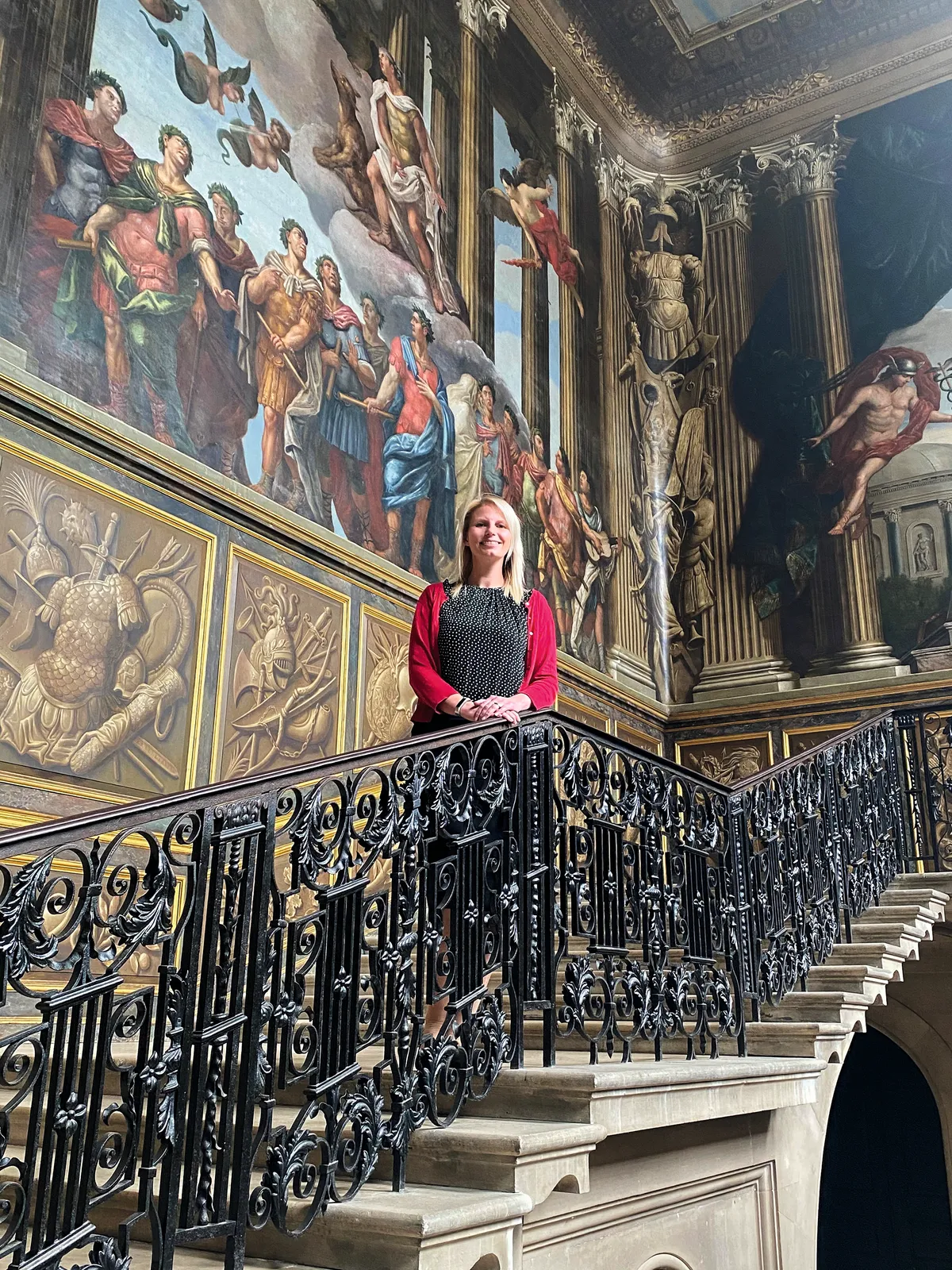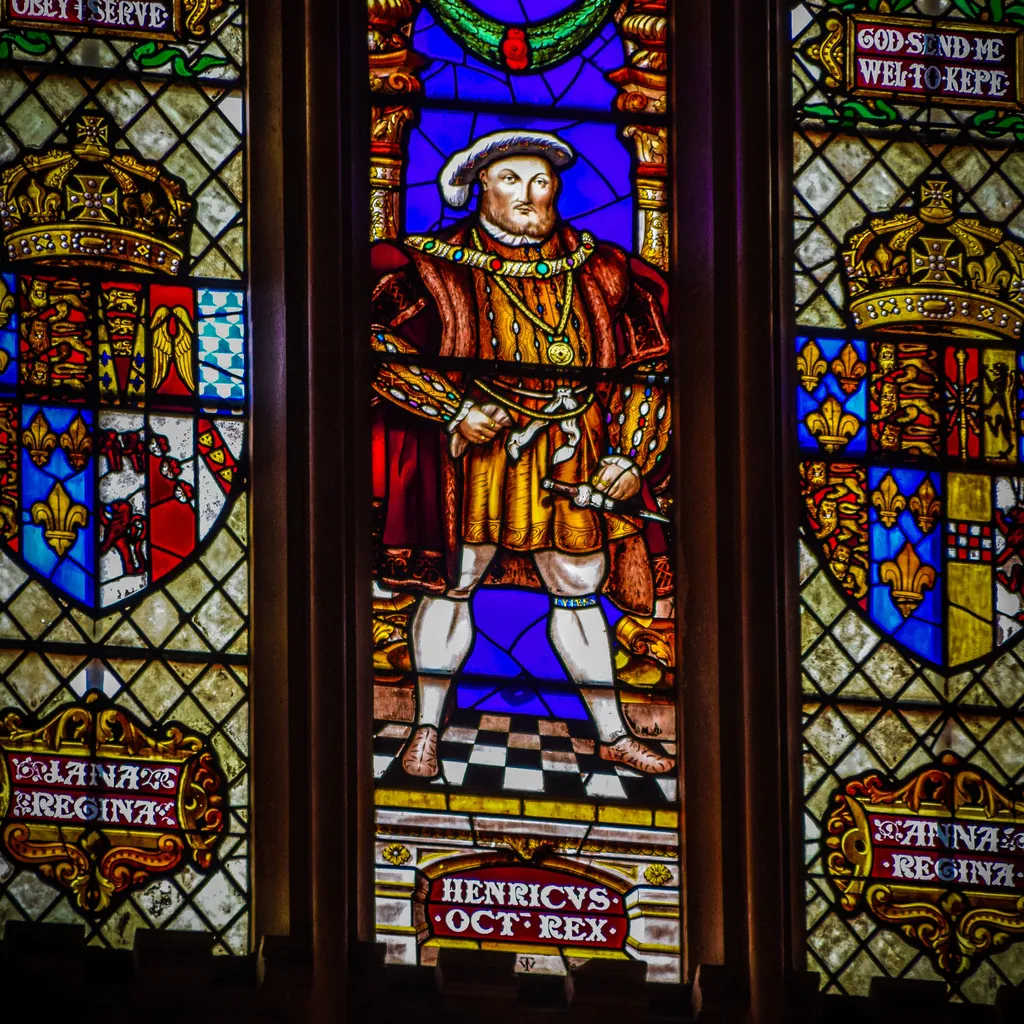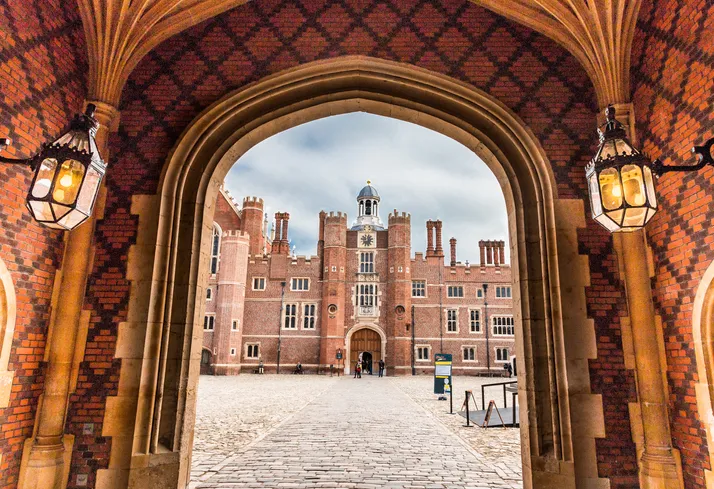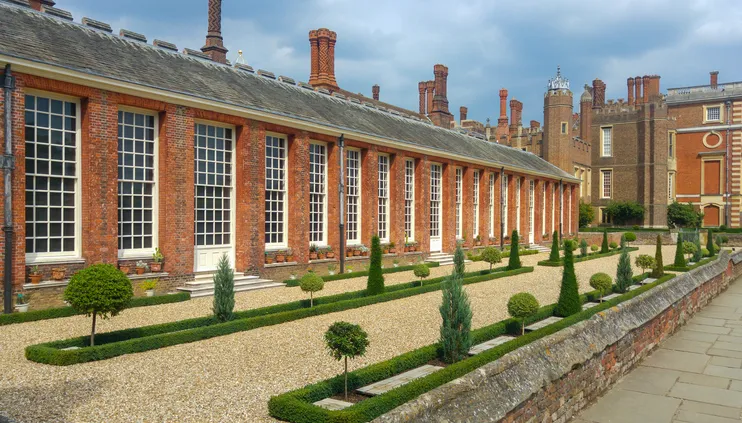With its elegant Palladian-style exterior, Hampton Court Palace is surrounded by gorgeous gardens and famous features such as the Great Vine and the Maze, which is one of the best in the UK.
It is full of history, attracting visitors from all over the world, and has been the setting for many nationally important events such as concerts and festivals.

Where is Hampton Court Palace?
Hampton Court Palace is located in East Molesey, in the London Borough of Richmond upon Thames, just 12 miles south-west and upstream of central London.
Who owns and lives in Hampton Court Palace?
Hampton Court Palace has been owned by the reigning monarch ever since Tudor times. Today, King Charles III owns the palace ‘in trust of the Crown’, however, the structure and grounds are cared for by the independent charity, Historic Royal Palaces.
Since the reign of King George II, no monarch has resided here, and from the 1760s the palace was used to house grace-and-favour residents. Many of them were impoverished aristocratic widows, who were offered free accommodation in return for their husbands’ services to the monarch.
Since 1838 when Queen Victoria was on the throne Hampton Court Palace has been open to the public. ‘There are over 1,300 rooms here to explore,’ says Lucy Hutchings, former Head of Hampton Court Palace.
As well as the grand rooms and halls, there’s also accommodation for the staff who work here. ‘I moved on-site permanently last March and, while I do live in a palace, my humble lodgings are quite ‘studenty’ – a lot of my furniture is in storage,’ says Hutchings.
‘I live right next door to the palace and my commute is a 30-second walk from my front door to the office. Part of the building is a holiday cottage, a Landmark Trust property, so visitors can come and stay. One of the perks is having the keys and being able to roam at my leisure. Usually I’m busy managing the palace, but in lockdown I had a good nose around, which was eye-opening.’
Among many highlights at Hampton Court Palace, you can view Queen Charlotte’s state bed, which is one of the most famous beds to view in the UK.

Who designed and built Hampton Court Palace?
In 1514, Cardinal Thomas Wolsey, the chief minister of Henry VIII, acquired a relatively small manor house on the site and constructed a magnificent palace around it.
Wolsey wanted to create a grand building where he could host not only the King and the royal court but also monarchs from across Europe.
King Henry VIII was so impressed by Wolsey's work that he forced his minister to relinquish the lease, which then passed into his ownership in around 1530, and has remained in the Royal family ever since.
It was William III and Mary II, who moved into the palace in the late 1600s, who commissioned Sir Christopher Wren to design the elegant baroque palace we see today, and which was built between 1689 and 1700.
William and Mary were also responsible for creating many of the most spectacular areas of the Hampton Court Gardens to complement their new palace – the Great Fountain Garden, created by Daniel Marot, and a new Privy Garden.
The yew trees of the Great Fountain Garden were once neatly pruned, but in the mid 18th century were allowed to grow to their present height by head gardener Capability Brown.

The history of Hampton Court Palace
Hampton Court Palace as we know it today began life as a relatively modest country house. Cardinal Thomas Wolsey, the chief minister of Henry VIII, saw its potential and began to expand the buildings and improve the surrounding landscape.
Wolsey invested huge sums of money in the transformation and the results were so impressive that King Henry VIII acquired the freehold and ownership in the 1531 – all six of his wives spent time at the Palace.
Henry VIII continued to expand and improve Hampton Court, creating a vast leisure complex that he used to demonstrate his magnificence and power in every possible way – from lavish banquets and extravagant court life to the expensive works of art that filled its walls.
In 1647 Charles I, who had used the Palace as a personal art gallery, found himself held prisoner at Hampton Court Palace – under house arrest – by the victorious Roundheads, following the English Civil war. And for the years of the Commonwealth of England (1649-1660) Oliver Cromwell made the Palace his home.
Hampton Court Palace as we know it today, was built when William III and Mary II took the throne in 1689. The new King and Queen commissioned Sir Christopher Wren to build an elegant new baroque palace.
Later, various Georgian kings and princes used the splendid interiors for entertaining and state events, if not as a place to live. From 1737, Hampton Court Palace was used as a home for grace-and-favour aristocrats as thanks for services to King and country.
In 1838 Queen Victoria opened the palace to the public and it has remained a magnet for millions of visitors, drawn to the grandeur, the ghosts and the fabulous art collection ever since.
We included Hampton Court Palace in our list of the most haunted stately homes and castles in the UK.

How much is Hampton Court Palace worth?
Hampton Court Palace was built for 200,000 crowns – this is equivalent to a modern value of £57.6mn. Today, the palace is estimated to be worth £1bn.

How to get to Hampton Court Palace
National Rail trains
Hampton Court train station is just a five-minute walk from the palace. National Rail train services run from London Waterloo every 30 minutes, calling at Vauxhall, Clapham Junction, Earlsfield, Wimbledon, Raynes Park, New Maldon, Berrylands, Surbiton, Thames Ditton and Hampton Court.
Hampton Court station is in zone 6 and Oyster cards are accepted on this route. Trains returning to London Waterloo depart Hampton Court station at regular times:
- Monday to Saturday: 24 and 54 minutes past the hour
- Sunday: 5 and 35 minutes past the hour
Bus
The following bus services run from Kingston and Richmond to Hampton Court:
- From Kingston: 111*, 216*, 411*, 461, 513 From Richmond: R68*
*These services accept Oyster cards, LT cards, bus passes, Travelcards, Freedom Passes and Saver Tickets.
London Underground
There is no London Underground station at Hampton Court, but the nearest Underground stations are in Richmond and Wimbledon, where connecting bus routes are available.
Visit Hampton Court Palace and take a tour
Hampton Court Palace has been open to the public since 1838 when Queen Victoria was on the throne. Visitors can see all the public rooms in the palace as well as the gardens, maze and the Magic Garden.
‘We usually welcome one million visitors a year,’ says Lucy Hutchings, former head of Hampton Court Palace. The Palace and gardens are open on Wednesdays through to Sundays throughout the year.
Private guided tours
Private guided tours are the perfect way to make the most of your visit to Hampton Court Palace. Starting from £132, they can cover the highlights of the palace’s history, or alternatively, take you on special thematic routes such as ghost stories and salacious secrets, origins of the Baroque palace and family friendly tours.
Book tickets to visit Hampton Court Palace

More stately home content from Homes & Antiques:
- Britain’s best stately homes
- The best castles you can stay in
- Our favourite stately home wedding venues around the UK
- Best haunted castles and stately homes to visit around the UK
- English stately homes made famous through film and TV
Sign up to our weekly newsletter to enjoy more H&A content delivered to your inbox.